 |
| Category:
Assorted |

|
|
|
|
|
|
Digger's Scrapbook Page 1 |
|

|
- This page is designed as a place
to put all those little bits 'n pieces that don't fit
anywhere else.
- It might be a newspaper clipping
or a funny fact or an interesting note.
- Look for it here; but don't look
for "good order and military discipline". Here, chaos
reigns supreme.
|
| Brigadier Generals (and Colonels) were
paid £2 5s 0d per day ($4.50), of which 8d (80 cents) was deferred
until discharge, plus while in the field, a field allowance of 7s 6d
(75 cents) per day. Major and Lieutenant Generals were paid a salary
of £1,200 ($2,400.00) per annum with a field allowance of 12s 6d
($1.25) per day. No special or additional payments were made to
generals in the Great War. Their pay can be compared with a private's
pay of 6s (60 cents) per day (of which 1s (10 cents) was deferred). |
 |
Flags of
Canada, Australia, New Zealand and the Cape Colony (South Africa) in
an advertising poster, circa 1915. |
|
Princess Mary's
Gift Box; Christmas 1914
|
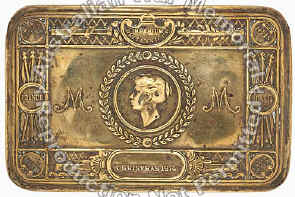 |
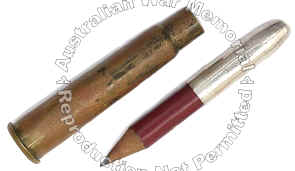 |
| Embossed
brass tin with a hinged lid and remnants of an overall gilt finish.
The lid features, at its centre, the profile head of Princess Mary
within a circular wreath, flanked on each side by the letter 'M'.
There is a decorative border portraying heraldic and military devices,
and the words 'IMPERIUM BRITANNICUM', 'CHRISTMAS 1914', and the names
'BELGIUM', 'JAPAN', 'FRANCE', 'RUSSIA', 'SERVIA' and 'MONTE NEGRO'. |
This
pencil was contained in a Princess Mary's Christmas Gift box. Sterling
silver; Wood (non specific); Lead; Brass; MK VI .303 brass bullet
cartridge containing a small pencil. Impressed on shaft of the
cartridge is Princess Mary's crest. The head-stamp on the cartridge is
'L VI C R' and a broad arrow. The 'head' of the bullet is made of
sterling silver and holds a small pencil which fits into the body of
the cartridge. |
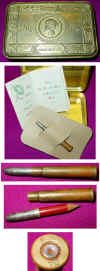 |
- Princess
Mary's gift tin was distributed to all British, Commonwealth and
Empire soldiers and sailors who were serving on Christmas Day,
1914.
- HRH
Princess Victoria Alexandra Alice Mary was responsible for a
public appeal to ensure that 'every Sailor afloat and every
Soldier at the front' received a Christmas present.
- Boxes
such as this one, given to Australian troops in Egypt, would
originally have contained a New Year's greeting card, a small
pencil in the form of a .303 bullet and cigarettes.
|
|
Pte JOHN KISSOCK
McDOWELL, M.M.
On 30th March, 1918,
in Sailly le Sec, South of Albert, Private McDowell was engaged in
preparing a hot meal for the troops in the trenches. His position was
heavily shelled and his comrades sought shelter. This man continued to
prepare the meal and make arrangements for its distribution, which
owing to his devotion to duty and courage was possible even during the
lulls in the enemy attack His conduct was much admired by the men of
his company and it was only due to his example and fine soldierly
bearing that the hot meal was able to be served to the troops
immediately the enemy's attack had been defeated. There was no officer
or N.C.O. who could supervise this important duty, and his example to
the other men of his kitchen is worthy of commendation. (McDowell was
KIA 26 May 1918).
|
| 'Colonel
Bogey' is arguably the most famous march ever written. First
published in 1914. By the early Thirties it had sold well over a
million copies. In 1958 it was chosen as the theme tune for the
splendid film The Bridge on the River Kwai . It
is of course a fine march whose opening has proved totally
irresistible for the best part of a century. Its composer was
Lieutenant F.J.Ricketts (1881-1945), a military bandmaster who was
Director of Music for the Royal Marines at Plymouth. Because at that
time Service personnel were not encouraged to have professional lives,
Ricketts published 'Colonel Bogey' and his other compositions under
the pseudonym Kenneth Alford.
So much for the composer Ė but who in fact was
Colonel Bogey? The story goes that this was a nickname by which a
certain fiery colonel was known just before the 1914 War when Ricketts
was stationed at Fort George near Inverness in Scotland. One of the
composer's recreations was playing golf and it was on the local course
that he sometimes encountered the eccentric colonel. One of the
latter's peculiarities was that instead of shouting 'Fore' to warn of
an impending drive, he preferred to whistle a descending minor third.
This little musical tag stayed and germinated in the mind of the
receptive Ricketts Ė and so the opening of a memorable march was
born. Copyright © Richard Graves,
April 7th 1999
|
| $2.5
billion were loaned by US banks to Allied forces in 1917, as opposed
to $45 million loaned to Germany. |
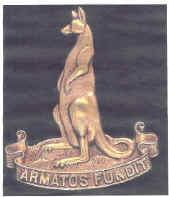 |
The kangaroo that got
"lost". This is a hat
badge but it is not Australian and not a badge from the colonies
either.
It is the hat badge of the Canadian
Armoured Carrier Regiment from
WW2. They complained that in England they were constantly mistaken for
Aussies......until the spoke and then they were mistaken for Yanks.
|
| Co-incidence.
My great/uncle served at the Siege of Tobruk and
was MID in New Guinea. On his death I requested that I be custodian of
his medals. T'was not to be. Several years later after other deaths
they did come to me to hold in trust. In the bag containing them were
two WWI medals (The War Medal & The Victory Medal) from someone
who has absolutely no connection with my family that I can discover.
They belong to Pte Wilfred Moore, KIA in 1917. His family were in
England. My G/uncle was not a medal collector or dealer. What is the
co-incidence? Pte Moore served with my
father in the 42nd Bn. |
|
Greatest Grenade
Battle of the War Undoubtedly the
greatest grenade battle of the war occurred on the Pozieres Heights on
the night of 26-27 July 1916.Lasting for twelve-and-a-half hours
without a break the Australians, with British support, exchanged
grenades with their German foes (who threw multiple types of grenade:
sticks, cricket balls, egg bombs and rifle grenades). The allied
contingent alone threw some 15,000 Mills bombs during the night. Many
grenadiers were killed that night, while many others simply fell down
due to complete exhaustion.
|
| AIF
DESERTER. AIF soldier Walter Lesley
Schwarz enlisted with the AIF in 1915, but felt he was being
discriminated against because of his name. He deserted in England and
joined the Royal Fusiliers. He became a Lieutenant winning an MC and
Bar and was mentioned three times in despatches. In 1921 King George V
granted him a pardon on the desertion charge. |
| "Donít
forget me, cobber". The sight of the
wounded lying helpless within a stoneís throw from safety so
affected Major A W Murdoch of the 29th Battalion that he
improvised a flag of truce, crossed no-manís land to the German
lines, and asked a Lieutenant if an informal truce could be declared
so the wounded could be rescued. The German officer received
permission from his HQ for the truce but Murdoch was told that the
Allied General HQ had given orders that "no negotiations of any
kind, and on any subject, were to be had with the enemy".
So the Australian stretcher
bearers were stopped from going out. Bean
wrote: "Then was seen along the whole front of the Australian 5th
Division that magnificent tribute of devotion which the Australian
soldier never failed to pay to his mates. "For three days and
nights, risking death or wounding, single men and parties continued to
go out to help the wounded. On the night of July
20, 300 men were rescued. One
of those who went to help was Lieutenant (then Sergeant) Fraser.
He found one man who was too
heavy for him to lift on his own. He was just about to go back for a
stretcher party when another man called out from 30 metres away:
"Donít forget me, cobber". Fraser and his stretcher
parties rescued both men. Fraser was killed a year later at the second
battle of Bullecourt and has no known grave.
|
 |
Britain
had signed an agreement that guaranteed Britain would support Belgium
if she was attacked. The Kaiser believed that no one would get
involved in a war for "a little scrap of paper". Once more
the Germans failed to understand the English. These are the flags of
the principal nations that fought on the British side. Britain,
France, Belgium, Russia, Japan, Australia, Canada, Cape Colony (Sth
Africa), New Zealand. There were others who took a smaller role. |
| When
is a Sergeant a Serjeant?
Normally in military and police contexts it is spelt sergeant (hence
sergeant-major), but in older use often written as serjeant. 'The
spelling serjeant is now usually restricted to legal and ceremonial
offices, except in historical and in certain official contexts' (New
Shorter Oxford English Dictionary). The New Fowler's Modern
English Usage, © Oxford University Press 1968 |
| Grenades.
Hand held bombs were called grenades. The soldiers who trained to use
them were called 'grenadiers' until the Grenadier Guards complained
that that usage would reflect badly on them and their name. So King
George V "requested" a change and the grenades became
'bombs' and the soldiers that used them were referred to as 'bombers'. |
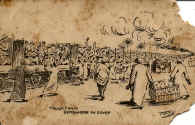 |
<<
Troop train Egypt c1915
Daily life,
Egypt c 1915 >>
|
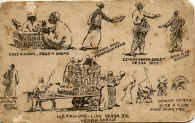 |
|
images from Gwen Ladner
|
 |
The gift of the
Colonies of Trinidad, Grenada & St Lucia to His Majesty's Naval
& Military Forces (WW1).
This chocolate was made from cocoa
grown in Trinidad Grenada & St Lucia
|
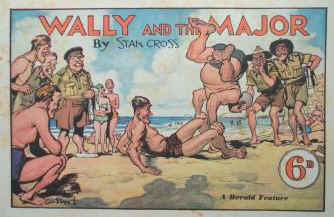 |
- "Wally & the
Major" was a popular Australian cartoon during WW2.
|
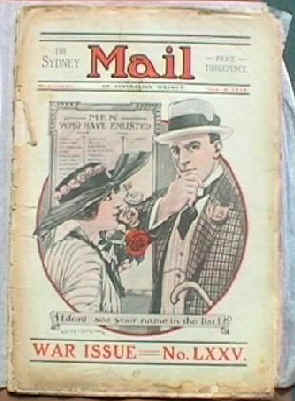 |
- This 1916 edition of The Sydney
Mail indicates how pressure was applied to men to enlist. It
carried lists of men who had enlisted and the front cover has
the woman saying to her man, "I don't see your name on the
list".
|
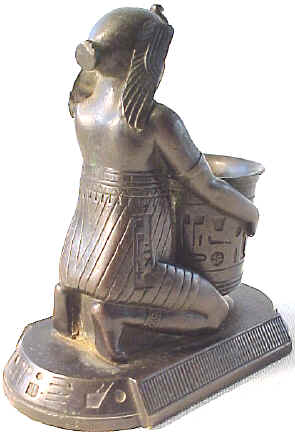 |
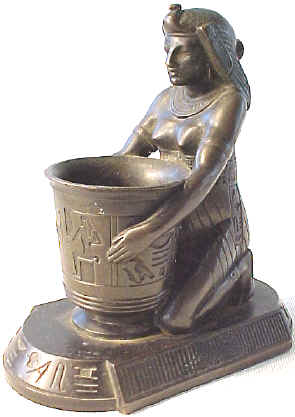 |
|
A souvenir brought
or sent home from Egypt by a Digger in 1915
|
| Memorials
to mounted men. If a memorial
has a mounted man on a horse with both front legs in the air it
indicates he died in battle. If the horse has one leg raised the
soldier died of wounds. If all four legs are on the ground the
soldier survived to die of natural causes. |
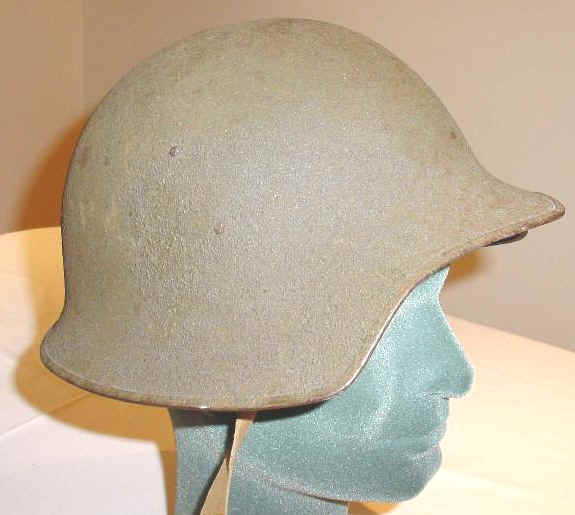 |
US ARMY HELMET
Helmet designed to
replace British style helmet to give better protection to wearer.
Designer Hale and
Kilburn of Philadelphia didn't take into account shape resembled
that of the enemy and troops didn't like the idea of being shot by
their own side.
Helmet made of
Hadfield Manganese and weighed 2lbs 10 ounces , helmet is sand / saw
dust finished very much like WW11 M1 helmet.
|
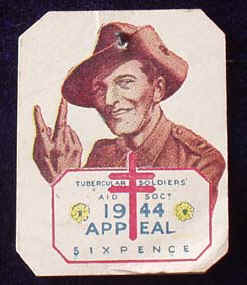 |
Whoops.
This 1944 fund-raising badge (value sixpence or 5 cents) was
obviously designed to capture the famous "V" for Victory sign
made popular by Winston Churchill.
However, the "V" for Victory
sign requires the other fingers to face the audience. As shown here it
has a meaning quite different from "V" for Victory.
I feel quite sure that the Tubercular
Soldiers' Aid Society did not mean "Get stuffed". |
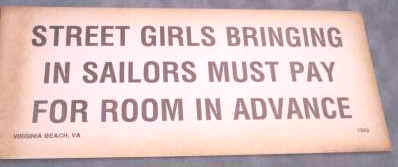 |
Sign in a hotel in Virginia Beach Virginia
USA in 1942 |
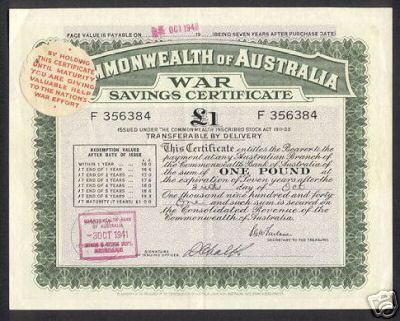 |
- Commonwealth of Australia War
Savings Certificate to the value of one pound (£1) (equivalent $2)
|
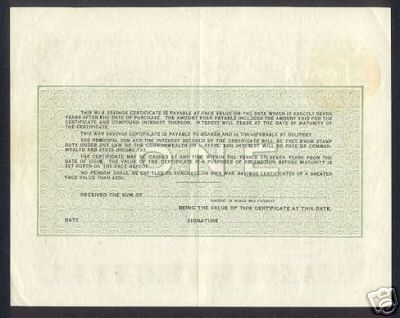 |
|
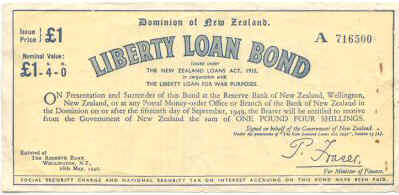 |
"Liberty
Bonds" were sold in both countries (separately) to raise money
to fight the war.
This 1942 NZ version shows that
the bond cost 1 pound and when redeemed in 1949 would be valued at 1
pound 4 shillings.
|
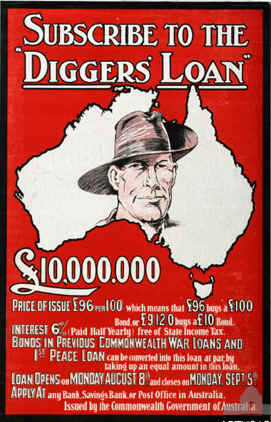 |
"Diggers'
Loan".
£96 (96 pounds or $192) buys a £100
(one hundred pounds or $200) bond.
Interest was paid at 6% paid half
yearly. |
 |
 |
|
Covers of books
produced for Anzac day 1916 & 1917 in Queensland Australia |
|

|

|
|
WW1 Soldier's
Certificate from Shire of Ararat |
Propaganda poster from
WW1 |
|